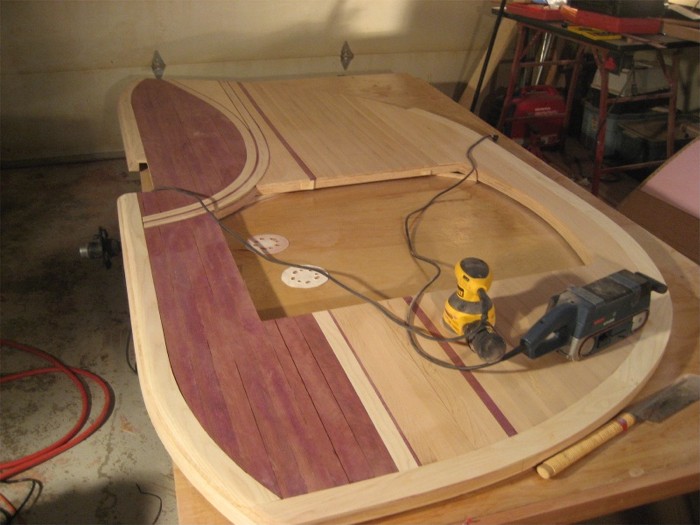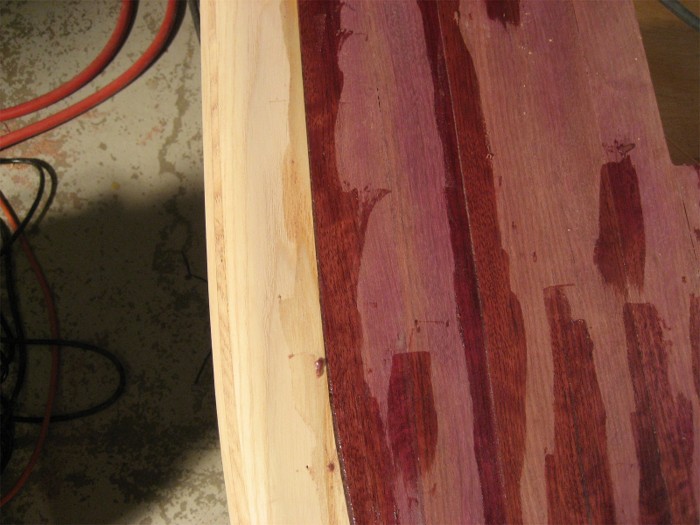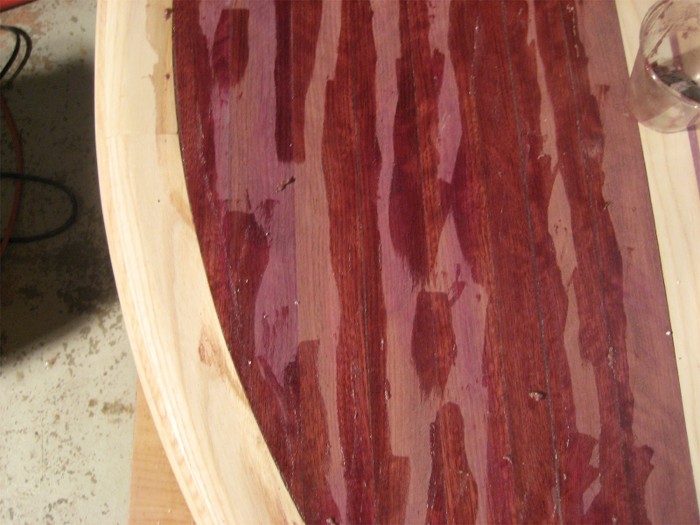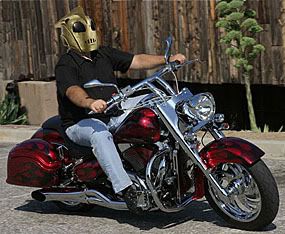Thanks Brian...
I thought maybe it would be usefull to show how I fill the cracks with epoxy. You know, it just seems that no matter how careful you are, you still get cracks, chips, gouges and all sorts of distressing ailments. But fortunately, epoxy makes a wonderful filler that can be made almost invisible. Here's how I do it...
On side two, I started the filling process by first laying down the side and rough sanding it. I used the handy dandy belt sander (my new best friend) to level it up... then a quick pass with the random orbital (ROS) at 100 grit to remove any sanding scratches. On the softer cedar, I also took a few licks with a fairing board to give me the flattest side that I could get.

While I was sanding with the ROS, I collected the dust out of the bag and set it aside. In this case, I have the purple heart dust in one container, some cedar dust in another. Your going to need those to get that good match. I also have available a variety of fillers from West (in differnt shades), clear plastic cups I can use to mix in, reusable stirring sticks, disposable gloves and so forth.

You start by mixing up some epoxy...notice that crack by the cup where the purple heart meets the ash? That's a very typical place to get a nice gap when you are scribing a fit (with one too many in ya). Because I am currently filling the purple heart, I'll start by adding the purple dust. In general, the initial sawdust /epoxy mix will be darker than the wood you want to match, so I will add various fillers a bit at a time till it is just the shade I want. I tend to use a lot of the West 403 to lighten.

After the filler is the right color and consitancy, I use the the plastic stirring stick to press the paste down in the cracks. I quickly have them all filled up. On the larger cracks, I may have to go over it with a second pass of filler once it cures and I sand the side down again.
It's pretty easy to get carried away with filling...the smallest of cracks begin to look like the Grand Canyon. Just remember...you'll have to sand all that extra off once it cures. Remember that crack in the picture above? You can see...I got a pretty good match and you will have to look to find it once the side is epoxied !!!


I'll repeat the process for each type of wood...and let it cure at least overnight.
And that's how I do it!!!!
I thought maybe it would be usefull to show how I fill the cracks with epoxy. You know, it just seems that no matter how careful you are, you still get cracks, chips, gouges and all sorts of distressing ailments. But fortunately, epoxy makes a wonderful filler that can be made almost invisible. Here's how I do it...
On side two, I started the filling process by first laying down the side and rough sanding it. I used the handy dandy belt sander (my new best friend) to level it up... then a quick pass with the random orbital (ROS) at 100 grit to remove any sanding scratches. On the softer cedar, I also took a few licks with a fairing board to give me the flattest side that I could get.
While I was sanding with the ROS, I collected the dust out of the bag and set it aside. In this case, I have the purple heart dust in one container, some cedar dust in another. Your going to need those to get that good match. I also have available a variety of fillers from West (in differnt shades), clear plastic cups I can use to mix in, reusable stirring sticks, disposable gloves and so forth.
You start by mixing up some epoxy...notice that crack by the cup where the purple heart meets the ash? That's a very typical place to get a nice gap when you are scribing a fit (with one too many in ya). Because I am currently filling the purple heart, I'll start by adding the purple dust. In general, the initial sawdust /epoxy mix will be darker than the wood you want to match, so I will add various fillers a bit at a time till it is just the shade I want. I tend to use a lot of the West 403 to lighten.
After the filler is the right color and consitancy, I use the the plastic stirring stick to press the paste down in the cracks. I quickly have them all filled up. On the larger cracks, I may have to go over it with a second pass of filler once it cures and I sand the side down again.
It's pretty easy to get carried away with filling...the smallest of cracks begin to look like the Grand Canyon. Just remember...you'll have to sand all that extra off once it cures. Remember that crack in the picture above? You can see...I got a pretty good match and you will have to look to find it once the side is epoxied !!!
I'll repeat the process for each type of wood...and let it cure at least overnight.
And that's how I do it!!!!

Last edited by Juneaudave on Sat Dec 01, 2007 8:52 pm, edited 1 time in total.
-

Juneaudave - Super Duper Lifetime Member
- Posts: 3237
- Images: 380
- Joined: Sun Jul 03, 2005 12:11 pm
- Location: Juneau, Alaska









